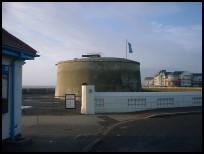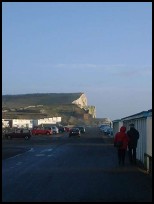| |

|
|
|
| |
 Seaford in East Sussex is a small town lying south of Lewes on the coast , and on the
opposite side of the river Ouse from the port of Newhaven. Seaford in East Sussex is a small town lying south of Lewes on the coast , and on the
opposite side of the river Ouse from the port of Newhaven.
The Romans had a large settlement on top of Seaford Head , probably
with their main port in the Cuckmere valley near Exceat , as the valley
would have been an inlet of the sea during the Roman period.
During the Saxon times it is believed that King Alfred the Great whose
palace was found at nearby West Dean , used the area for his fleet and
defense of the area from the Vikings .
The Domesday book records that the town provided 20 ships for the
service of the crown, so it must have been a wealthy port even in
those times.
Seaford has been associated with the Cinque Ports from the mid 12th
century, where it is reported as a limb(associate) of Hastings . The
document records that Seaford , Pevenshey( Pevensey ), Hodeney ,
Winchelsey ( Winchelsea ) , Rye , Ihame ( Icklesham ) , Bekesborne , Grenge ,
Northie ( Northeye ), Bulwerhethe ( Bulverhythe ) were all associated with
Hastings . By 1290 Seaford was one of the major ports in the South of England
exporting wool from the area and importing wine.
The 100 Years War which started in 1337 marked the end of Seaford as a
wealthy port, with the French continuously raiding the town, and then
the Black Death hitting the town badly in 1348 . By 1357 the town was
reported to have been mostly burnt down and that there were not enough
people left to defend the town.
Seaford used to have a fine harbour which by the late 1500's had silted
up, making landing impossible, and the harbour was moved to nearby
Newhaven about 2 miles to the west some time before 1565 .
The area continued to be raided by the French until 1545 when they
attacked Brighton , Newhaven and Seaford , Sir Nicholas Pelham from
nearby Laughton together with a band of locals drove the French off.
From 1562 the people of Seaford were known as the 'cormorants' or 'shags'
because of their efficiency in looting ships wrecked in the bay. They
were also not averse to helping ships run aground with fake harbour lights
on the cliffs.
The civil war found Seaford on the side of the Parliamentarians together
with the other Cinque Ports .
The Napoleonic Wars brought the construction of the Martello tower number
74 in 1811, which was the most western tower in the chain stretching from
Hythe in the East.
On June 1st 1863 work started on the branch line from Newhaven which was
completed the next year. It was built on an embankment which acted as a
flood barrier , helping to prevent the flooding which had influenced the
area in previous times. The railway was the key to the current Seaford ,
in that it unlocked tourist traffic into the town. The only problem
that Seaford had as a seaside resort was that it was near Brighton with
its easy access to London, so that Seaford never made it as a serious
resort.
However nowadays Seaford is a very pleasant seaside town and well worth
visiting. |
|
 Seaford in East Sussex is on the coast, and although the beach is made of
shingle it is very pleasant place to visit. Seaford in East Sussex is on the coast, and although the beach is made of
shingle it is very pleasant place to visit.
To the east are the South Downs with their wide views and many
walks. The best views of the Cuckmere Haven and the iconic view of
the Seven Sisters can be seen by parking in the car park to the
east of Seaford golf course, and walking about three quarters of a
mile down to Cuckmere Haven .
In the town is Martello Tower No74, which is currently a museum
with a very extensive range of exhibits, making it a bit like
Dr Who's Tardis from the BBC TV series, which looks small on
the outside but large on the inside. |
|
 Seaford in East Sussex has a wide range of services as you would expect from
a small town. There are many shops locally, and if you travel
to Newhaven about 2 miles to the west there are a number of
larger supermarkets. Seaford in East Sussex has a wide range of services as you would expect from
a small town. There are many shops locally, and if you travel
to Newhaven about 2 miles to the west there are a number of
larger supermarkets.
The trains run from the station into Lewes for transfer on to
the coastal lines.
Busses service the town with regular services to Lewes and
Eastbourne . |
|
| Seaford is shown as the red symbol on the map. |
|
|
Nearby Villages
(click on symbol to see the village page) |
| Village= | |
Town= | |
Recorded in Domesday= |  |
| |
|
|
Alciston |
(Fifty thousand tiles on the Barn) | | 4.21 miles |
|
|
Alfriston |
(Smuggling and Ghosts) | | 3.42 miles |
|
|
Berwick |
(Sharpen your arrows on the Church) | | 4.17 miles |
|
|
Bishopstone |
(Largest Tide-Mill in Sussex) | | 1.29 miles |
|
|
Denton |
(Earl Godwins Manor) | | 2.64 miles |
|
|
East Blatchington |
(Mutiny and the Edge of Space) | | 0.39 miles |
|
|
East Dean |
(Fishing and Wrecking) | | 4.78 miles |
|
|
Exceat |
(Alfred the Great's Naval Base?) | | 2.24 miles |
|
|
Folkington |
(Teasles and Badgers) | | 5.53 miles |
|
|
Friston |
(Home of the Railway Children) | | 4.57 miles |
|
|
Jevington |
(Smugglers and Churchill Tanks) | | 5.16 miles |
|
|
Litlington |
(Secret marriage of George IV) | | 2.74 miles |
|
|
Lullington |
(destroyed by Cromwell ??) | | 3.39 miles |
|
|
Polegate |
(Fine old Tower Mill) | | 7.19 miles |
|
|
Tarring Neville |
(The Chest from the Spanish Armarda) | | 3.93 miles |
|
|
Wilmington |
(The Long Man) | | 5.04 miles |
|
|
| Copyright Villagenet 1998-2025 | |
| |
|
|
Local Interest
Just click an image |
|
|
|
|
|
|
|
|
|
|
|
|
|
|
| |